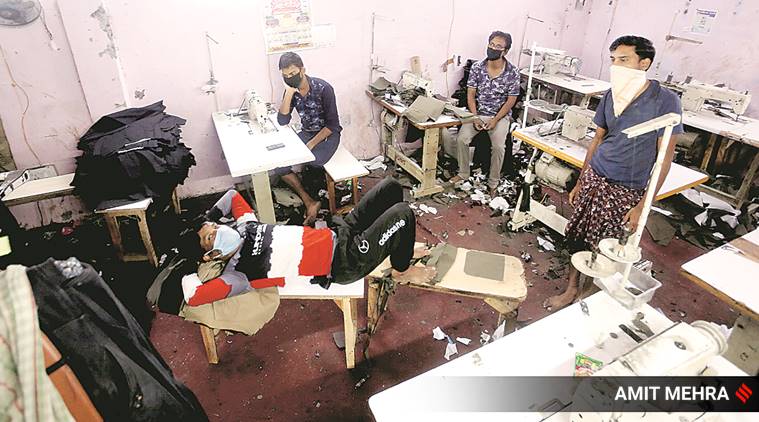 Tailors at a factory in Gandhi Nagar, where they are staying, Sunday. (Express Photo by Amit Mehra)
Tailors at a factory in Gandhi Nagar, where they are staying, Sunday. (Express Photo by Amit Mehra)
The narrow lane leading to a makeshift kitchen in Northeast Delhi’s Gandhi Nagar is littered with dead rats, but the men standing in line for breakfast pay no heed.
Before the lockdown, they worked as tailors at cloth markets in Gandhi Nagar, Asia’s largest garment market, and earned enough to keep their families fed for a week. As the first phase of the lockdown ended, so did their stock of ration, and many used up their savings to feed families.
Now, they have no choice but to stand in line for hours to get two dry rotis, a handful of dal and a single onion.
Amarpal (55) has worked as a tailor for more than two decades at Gandhi Nagar. It took him 15 minutes to stitch a green face mask with a patch of cloth meant to make the inner pocket of a jeans. Despite the Delhi government asking landlords not to take rent from tenants during the lockdown, Amarpal’s landlord locked his bathroom, mounting pressure on him to pay Rs 2,000. Munching down an onion on Sunday, he said: “The owners get paid in lakhs and we are left with nothing.”
With around 15,000 shops and over 2.5 lakh skilled workers, the Gandhi Nagar market has seen its fair share of crises this year. First, said traders, it was the Northeast Delhi violence that robbed them of their workers who lived in riot-hit areas. Now, the coronavirus has demolished any chances of revival.
Sanjay Jain, vice-president of the Ram Nagar Market Association, said, “Salaries of workers for March have been paid, but it will be difficult to pay (for April)… We had stocked up on half-sleeve shirts. They have all gone to waste — by the time we can operate, the major festivals would have ended.”
Shahid-ul-Islam (40) used to earn Rs 15,000 per month, enough to sustain his wife and 15-year-old son. He ran out of money five days ago and now stands in a line outside a local school for food. “Khana nahi milega toh biwi bache ko kya muh dikhaunga,” he said.
Outside a one-room house barricaded with a Chinese fast-food cart stands Kanta Devi (32), a thread cutter who earned Rs 150 for eight hours of work. Her husband sells chowmein, earning around Rs 5,000 per month. They had bought around 25 kg of aata and rice, which has run out. “Lockdown kab khatam hoga? Aur nahi ho payega,” said Kanta.
Lockdown restrictions to be eased from April 20: Here’s a list of what opens and what does not
Their neighbour Sheetal, who also works as a thread cutter, has returned with three pieces of roti and a jar half-filled with dal. She has 10 members in her family living. With all their money spent on ration, her 10-year-old son has been asked to sell beedis to keep the family afloat. “Kya karein? Zinda rehna hai,” said Sheetal.
Sangeeta Devi, another thread cutter with four children to feed, has kept count of all the times she returned empty-handed. On Sunday, she stood in line for three hours and managed to get some rice and dal. “Paanch baar khana nahi mila,” she said.
Some have managed to find other work during the lockdown, like several young men who have taken up jobs as security guards. They patrol the empty streets of the markets every two hours, hoping they will be paid later.
Others have become vegetable vendors, using their savings to purchase weighing machines and wooden carts. Ram Naresh, who used to stitch school uniforms, spends three hours procuring the vegetables from Ghazipur Mandi and manages to earn Rs 150 every day. “Bhook lagi toh sabzi ki kami nahi,” he said.
Locked shops in the market tell the story of those who went back home, but if one pays attention, there are signs of life. In one such locked pyjama-making unit stay five tailors from West Bengal. They were earning around Rs 450 a day before the lockdown. Their house is the garment factory, and they have been taking baths on the terrace and sleeping on benches. They were eating half- cooked rice before finally getting 25 kg rice from their owner.
One of the men, Jahangir Hussain, said: “I don’t think about my hunger. I think about my family stuck in West Bengal… their hunger. I don’t have a phone to call them.”
Don’t miss these articles on Coronavirus from the Explained section:
‣ How coronavirus attacks, step by step
‣ Mask or no mask? Why the guidance has been shifting
‣ Besides a face cover, should I wear gloves when I go outdoors?
‣ How the Agra, Bhilwara and Pathanamthitta Covid-19 containment models differ
‣ Can coronavirus damage your brain?